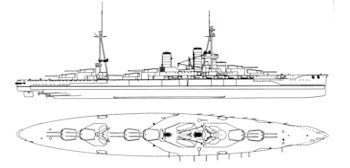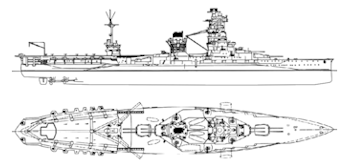




The two battleships of the Ise-class were originally intended to be the third and fourth ships of the preceding Fuso-class. However, delays in funding resulted in a redesign which helped alleviate some structural drawbacks. Although the Ise ships retained the same twelve 14-in Vickers guns, the two previously separate midship turrets were paired up, thereby reducing blast effects and making the magazines less vulnerable. A new 5.5-in gun for the secondary armament was also designed with a higher rate of fire than the Fuso's 6-in guns; these too were arranged in casemates. Armor protection was very similar to the Fuso ships, which despite being adequate for their time, were vulnerable to long-range plunging fire. Protection was later increased during modernization in the interwar years, as was the installation of torpedo bulges and bulkheads. With a top speed of around 24 knots, the Ise-class was seen as too vulnerable to operate independently and it was later decided to convert them into hybrid carriers in 1943. This involved a reconstruction of the aft superstructure to accommodate a 70-m long flight deck plus a hangar. Although theoretically capable of carrying an air group of 22 aircraft (D4Y 'Judy' dive bombers and E16A 'Paul' recon planes), in practice this was usually less and as such, were never really useful as either capital ships or carriers. Both ships participated and survived the Battle of Leyte Gulf but were sunk at harbor in Kure late in the war.
Both the Ise and the Hyuga undertook patrols during the Sino-Japanese War, and were available for distant support for the attack on Pearl Harbor. They participated in the invasion of the Aleutians that coincided with the Battle of Midway. Both ships (now turned into hybrid carriers) were used as part of the decoys in the Northern Force under Adm Ozawa during the Battle of Cape Engaño (part of the Battle of Leyte Gulf). Although damaged, both ships survived and were sent back to Japanese waters for the remainder of the war. Like most remaining Japanese capital ships, they were sunk at Kure by carrier aircraft in July 1945.
 |  |  | |
| Class | Ise | Ise (1936) | Ise (1943) |
| Type | Battleship | Battleship | Battleship-Carrier |
| Year | 1917 | 1936 | 1943 |
| Crew | 1360 | 1360 | 1360 |
| Dimensions | |||
| Length | 195.1 m (pp) 205.8 m | 195.1 m (pp) 205.8 m | 195.1 m (pp) 205.8 m |
| Beam | 28.7 m | 28.7 m | 28.7 m |
| Draught | 8.8 m | 8.8 m | 8.8 m |
| Displacement | |||
| Empty | 31,260 t | 31,260 t | 31,260 t |
| Loaded | 36,500 t | 36,500 t | 36,500 t |
| Performance | |||
| Speed | 43 km/h | 43 km/h | 43 km/h |
| Range | 17,927 km @ 26 km/h | 17,927 km @ 26 km/h | 17,927 km @ 26 km/h |
| Machinery | |||
| Shafts | 4 | 4 | 4 |
| Turbines | 4 x Geared steam 45,000 hp Curtis/Parsons | 4 x Geared steam 45,000 hp Curtis/Parsons | 4 x Geared steam 45,000 hp Curtis/Parsons |
| Boilers | 24 x Kampon | 24 x Kampon | 24 x Kampon |
| Fuel | Coal: 4,706 t | Coal: 4,706 t | Coal: 4,706 t |
| Armament | |||
| Main | 12 x 360-mm/45 (6 x 2) 36cm/45 Type 41 -5° / +43° | 12 x 360-mm/45 (6 x 2) 36cm/45 Type 41 -5° / +43° | 12 x 360-mm/45 (6 x 2) 36cm/45 Type 41 -5° / +43° |
| Secondary | 20 x 140-mm/50 (20 x 1) 14cm/50 Type 3 -7° / +20° | 20 x 140-mm/50 (20 x 1) 14cm/50 Type 3 -7° / +20° | 20 x 140-mm/50 (20 x 1) 14cm/50 Type 3 -7° / +20° |
| Anti-Aircraft | 4 x 76-mm (4 x 1) 8cm/40 Type 41 | 4 x 76-mm (4 x 1) 8cm/40 Type 41 | 4 x 76-mm (4 x 1) 8cm/40 Type 41 |
| Torpedo tubes | 2x3 x (21-in) | 2x3 x (21-in) | 2x3 x (21-in) |
| Armor | |||
| Belt | 102 - 305 mm | 102 - 305 mm | 102 - 305 mm |
| Deck | 56 - 33 mm | 56 - 33 mm | 56 - 33 mm |
| Barbettes | 203 - 305 mm | 203 - 305 mm | 203 - 305 mm |
| Gun turret | 203 - 305 mm | 203 - 305 mm | 203 - 305 mm |
| Conning tower | 152 - 305 mm | 152 - 305 mm | 152 - 305 mm |
| Production | |||
| Built | 2 | 2 | 2 |
| Total | 2 |
| Ship | Code | Builder | Laid | Launch | Comm | Decomm | Fate | ||
 |
Ise † | Kawasaki | 10/05/1915 | 12/11/1916 | 15/12/1917 | 28/07/1945 | † | Loss by aircraft | |
 |
Hyuga † | Mitsubishi | 06/05/1915 | 27/01/1917 | 30/04/1918 | 28/07/1945 | † | Loss by aircraft |